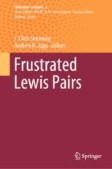Search
Search Results
-
B(C6F5)3-based Lewis pair-catalyzed acrylate polymerization: Lewis base effects on pairing interactions
Acrylate polymerizations catalyzed by Lewis pairs (LP) composed of B(C 6 F 5 ) 3 and various Lewis bases (phosphines, amines, and an N-heterocyclic...

-
Comparative Selective Conversion of Biomass-Derived Mono- and Polysaccharides into Lactic Acid with Lanthanide Lewis Acid Catalysts
Lanthanides were tested (Ce 3+ , Er 3+ , and Yb 3+ ) as catalysts to produce lactic acid (LA) from the monosaccharides present in corn stover (glucose,...

-
Lewis acid-mediated Suzuki–Miyaura cross-coupling reaction
The palladium-catalysed Suzuki–Miyaura cross-coupling reaction of organohalides and organoborons is a reliable method for carbon–carbon bond...

-
Research progress in the living/controlled polymerization of (meth)acrylate monomers by Lewis pair
Lewis pair polymerization (LPP) has demonstrated its unique advantages, such as high activity, high stability, and adjustable variability, towards...

-
Multilayer Nb2CTx (MXene) Supports CoB for the Selective Hydrogenation of Cinnamaldehyde to Cinnamyl Alcohol: Effect of the Electron-Modified CoB Site and Lewis Acid Site
A heterogeneous CoB/Nb 2 CT x catalyst was successfully prepared by in situ wet reduction of Co metal ions electrostatically adsorbed on the surface of...

-
Lewis acid-catalyzed Diels–Alder cycloaddition of 2,5-dimethylfuran and ethylene: a density functional theory investigation
Density functional theory calculations with the M06-2X exchange–correlation functional have been performed to explore the Diels–Alder reaction...

-
Shedding Light on the Lewis Acid Catalysis in Organic Transformations Using a Zn-MOF Microflower and Its ZnO Nanorod
The Lewis acidic nature of both {[Zn 4 (µ 3 -OH) 2 ( d -2,4-cbs) 2 (H 2 O) 4 ] . 5H 2 O} n (Zn-CBS ) and its ZnO nanostructures ( ZnO_1 , 3D microflower; ZnO_2 , 3D...

-
Unveiling novel reactivity of P/Al frustrated Lewis pair: ring size-dependent activation of cyclic ethers/thioethers and CO2 insertion therein
Rational design strategies for the Lewis acid and Lewis base functionalities have been probed using a series of “frustrated Lewis pairs” (FLPs)...

-
Palladium-catalysed selective oxidative amination of olefins with Lewis basic amines
Amines are prominent in natural products, pharmaceutical agents and agrochemicals. Moreover, they are synthetically valuable building blocks for the...

-
A Novel Nanoencapsulated Zirconium(IV) Chloride Using Non-cross-linked Polystyrene as a Recyclable Lewis Acid Catalyst: Synthesis, Characterization, and Performance Towards Acylation of Alcohols and Phenols
Zirconium(IV) chloride/polymer composite nanocapsules with multiple ZrCl 4 cores embedded in a non-cross-linked polystyrene shell were first...

-
Quantum Chemical Modeling of Reactions of the Catalytic Transformation of Alkanes
AbstractDFT b3lyp quantum chemistry is used to study the electronic structure of complex n -hexane with aluminosilicate clusters ZSM-5 and Н-ZSM-5 in...

-
Al-containing Ge-rich IWV: rapid synthesis via interzeolite transformation and application in Baeyer-Villiger oxidation
Ge-containing Lewis acidic zeolites are typically synthesized using a conventional hydrothermal strategy from amorphous silica sources, through a...
-
Study on Preparation of Sn–Er–Beta Zeolite and Its Catalysis of Glucose to Lactic Acid
A porous Sn–Er–Beta zeolite catalyst was rapidly prepared by introducing Sn source with water bath method and Er source with solid-state ion exchange...

-
Lewis Acidic Boranes in Frustrated Lewis Pair Chemistry
From their inception, boron-based frustrated Lewis pairsFrustrated Lewis pair (FLP) have garnered significant scientific attention thanks to the...
-
Efficient Lewis acid catalysis of an abiological reaction in a de novo protein scaffold
New enzyme catalysts are usually engineered by repurposing the active sites of natural proteins. Here we show that design and directed evolution can...

-
Heterogeneous Catalysis by Frustrated Lewis Pairs
Frustrated Lewis pairs (FLPs)Frustrated Lewis pair (FLP), featuring reactive Lewis acidLewis acid and Lewis baseLewis base sites that can...
-
Directed Synthesis of Biologically Interesting Heterocycles with Squaric Acid (3,4-Dihydroxy-3-cyclobutene-1,2-dione) Based Technology
A variety of methods for organic transformation starting from squaric acid have been developed in this decade. These are based on conversion of...
-
Highly sensitive sensing and quantitative detection of sulfate ion with a SERS chip-based on boric acid’s Lewis effect
Based on the Lewis acid’s coordination principle, a surface-enhanced Raman scattering (SERS) chip strategy had been developed for the ultrasensitive...

-
Chemoselective Synthesis of Propionic Acid from Biomass and Lactic Acid Over a Cobalt Catalyst in Aqueous Media
A new non-fermentative process for the transformation of biomass carbohydrates and lactic acid (LA) into propionic acid (PA) was first reported over...
-
Thio-, Seleno-, and Telluro-Carboxylic Acid Esters
This chapter reviews studies into the preparation of thio-, seleno-, and telluro-carboxylic acid esters (referred to thiol, selenol, and tellurol...
